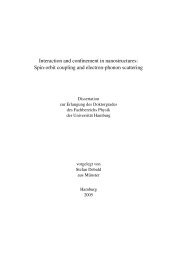Measuring the Electron Beam Energy in a Magnetic Bunch ... - DESY
Measuring the Electron Beam Energy in a Magnetic Bunch ... - DESY
Measuring the Electron Beam Energy in a Magnetic Bunch ... - DESY
Create successful ePaper yourself
Turn your PDF publications into a flip-book with our unique Google optimized e-Paper software.
Feedforward is a term describ<strong>in</strong>g an element <strong>in</strong> a control system that delivers<br />
commands <strong>in</strong> a pre-def<strong>in</strong>ed way, without respond<strong>in</strong>g to how <strong>the</strong> system reacts. A fixed<br />
setpo<strong>in</strong>t table that takes <strong>in</strong>to account various calibrations done at an earlier time is an<br />
example of feedforward. After <strong>the</strong> effects of Lorentz-force detun<strong>in</strong>g, cavity detun<strong>in</strong>g, and<br />
imbalances <strong>in</strong> <strong>the</strong> actuator cha<strong>in</strong> have been calibrated away over weeks of studies <strong>in</strong> <strong>the</strong><br />
absence of beam production, a fixed feedforward (setpo<strong>in</strong>t) table can be determ<strong>in</strong>ed.<br />
When <strong>the</strong> beam is <strong>the</strong>n added to <strong>the</strong> system, a slope on <strong>the</strong> RF pulse arises due to<br />
someth<strong>in</strong>g called beam load<strong>in</strong>g. <strong>Beam</strong> load<strong>in</strong>g occurs when an electron bunch enters <strong>the</strong><br />
accelerat<strong>in</strong>g cavity. The beam takes energy out of <strong>the</strong> accelerat<strong>in</strong>g field and this energy<br />
must be replaced by <strong>in</strong>creas<strong>in</strong>g <strong>the</strong> klystron’s output. If, <strong>in</strong> one bunch tra<strong>in</strong>, each bunch<br />
took a certa<strong>in</strong> amount of energy out of <strong>the</strong> cavity, <strong>the</strong> same th<strong>in</strong>g is likely to happen <strong>in</strong> a<br />
subsequent bunch-tra<strong>in</strong>, as long as <strong>the</strong> beam charge or orbit is not significantly changed.<br />
A fixed feedforward table may be appropriate for one set of beam parameters, but as soon<br />
as <strong>the</strong> mach<strong>in</strong>e operator changes <strong>the</strong> setup of <strong>the</strong> mach<strong>in</strong>e, <strong>the</strong> feedforward table will<br />
have to be manually tuned to compensate for changes <strong>in</strong> beam load<strong>in</strong>g.<br />
In <strong>the</strong> absence of an expert to tune <strong>the</strong> feedforward table, an adaptive feedforward<br />
algorithm us<strong>in</strong>g “Iterative Learn<strong>in</strong>g Control” can automatically change <strong>the</strong> feedforward<br />
table <strong>in</strong> order to counteract <strong>the</strong> changes <strong>in</strong> beam load<strong>in</strong>g. The control decisions of <strong>the</strong><br />
adaptive feedforward algorithm do not take place with<strong>in</strong> <strong>the</strong> bunch-tra<strong>in</strong>, but after<br />
averag<strong>in</strong>g over multiple bunch-tra<strong>in</strong>s. The adaptive feedforward can not only remove<br />
slopes from <strong>the</strong> bunch tra<strong>in</strong>, it can also, <strong>in</strong> pr<strong>in</strong>ciple, remove ripples. If ripples are<br />
periodic and appear <strong>in</strong> bunch-tra<strong>in</strong> after bunch-tra<strong>in</strong> with <strong>the</strong> same phase, <strong>the</strong>y can be<br />
removed through <strong>the</strong> feedforward. An adaptive feedforward control can identify patterns<br />
<strong>in</strong> <strong>the</strong> cavity signals dur<strong>in</strong>g one klystron pulse and attempt to remove those patterns by<br />
apply<strong>in</strong>g a pattern of equal and opposite amplitude <strong>in</strong> a subsequent klystron pulse. This<br />
control option has not, however, been used for day-to-day beam operation due to <strong>the</strong><br />
<strong>in</strong>completeness of its implementation. The <strong>in</strong>completely debugged failure modes of <strong>the</strong><br />
controller have caused <strong>the</strong> superconduct<strong>in</strong>g cavities to quench. New versions of <strong>the</strong><br />
controller are under development [11].<br />
Feedback is different from feedforward <strong>in</strong> that it sets control parameters based on<br />
<strong>the</strong> reaction of <strong>the</strong> system to <strong>the</strong> control parameters. It utilizes measurements taken at <strong>the</strong><br />
beg<strong>in</strong>n<strong>in</strong>g of <strong>the</strong> pulse <strong>in</strong> order to change <strong>the</strong> sett<strong>in</strong>gs of <strong>the</strong> klystron with<strong>in</strong> <strong>the</strong> pulse. The<br />
current system can implement Proportional, Integral and Differential (PID) feedback<br />
control, but for typical operation, only <strong>the</strong> proportional feedback is used. Feedback is<br />
limited by measurement resolution and latency, how long it takes for a signal to be<br />
measured, <strong>in</strong>terpreted, and converted <strong>in</strong>to a control parameter. With Field Programable<br />
Gate Arrays (FPGAs), Analog-to-Digital Converters (ADCs), and Digital-to-Analog<br />
Converters (DACs) able to process signals at more than 100 MHz, or every 10 ns, and<br />
signal transport times that can be kept below 100 ns, bunch-to-bunch feedback with<strong>in</strong> <strong>the</strong><br />
FLASH bunch spac<strong>in</strong>g of 1 μs and even <strong>the</strong> XFEL bunch spac<strong>in</strong>g of 200 ns becomes a<br />
goal with<strong>in</strong> reach. The latency of present systems is currently limited to ~3 μs, but <strong>in</strong><br />
certa<strong>in</strong> locations where cable lengths can be m<strong>in</strong>imized, faster performance could be<br />
realized with future hardware.<br />
While <strong>the</strong> delivery of control decisions to <strong>the</strong> klystron between bunches is<br />
possible, mak<strong>in</strong>g large changes <strong>in</strong> <strong>the</strong> field of <strong>the</strong> accelerat<strong>in</strong>g structure at that rate is<br />
physically limited due to <strong>the</strong> large quality-factor, or small bandwidth of <strong>the</strong> cavity. Large<br />
20

















